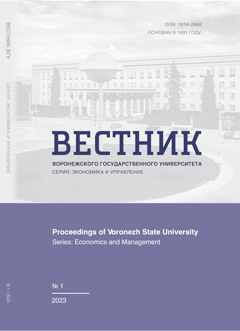Эволюция управления бизнес-процессами и реализация инициатив по совершенствованию бизнес-процессов
Аннотация
Предмет. Рассматривается эволюция управления бизнес-процессами – от проектирования отдельных бизнес-процессов до самостоятельной дисциплины менеджмента и современного понимания управления бизнес-процессами как комплексного набора организационных способностей. Акцент сделан на анализе лучших практик реализации проектов по совершенствованию бизнес-процессов.
Цель. Анализ современных теоретических и прикладных аспектов управления бизнес-процессами, причин провала и успеха проектов по совершенствованию бизнес-процессов, определение оптимальной организации, структуры и порядка работы проектных команд по совершенствованию бизнес-процессов.
Метод. Обзор литературы, анализ прикладных исследований и кейсов.
Результат. Определены условия организации проектных работ по совершенствованию бизнес-процессов, необходимая квалификация членов команды проекта, общая структура участников проекта по совершенствованию бизнес-процессов (команда проекта, команда поддержки (пилотная группа), комитет по проверке контрольных точек, команды подпроектов). Уточнено содержание этапов работ по совершенствованию бизнес-процессов.
Вывод. Потенциал управления бизнес-процессами и инициатив по совершенствованию бизнес-процессов может быть реализован при условии их встраивания в важнейшие компоненты управления организации, такие как стратегия, структура, организационная культура, информационно-коммуникационные технологии, управление персоналом. Не менее важно постоянное развитие компетенций: не только в анализе и моделировании бизнес-процессов, но и управлении проектами и организационными изменениями.
Metrics
Литература
Aarnio, T. (2015) The Strengthened Business Process Matrix – A Novel Approach for Guided Continuous Improvement at Service-Oriented SMEs. Knowledge and Process Management. 22 (3), 180–190. DOI: 10.1002/kpm.1473
Bakotich, D., & Krnich, A. (2017) Exploring the relationship between business process improvement and employees’ behavior. Journal of Organizational Change Management. 30 (4), 1044–1062. DOI: 10.1108/jocm-06-2016-0116
Clark, K. (1998) Dynamic Manufacturing Creating the Learning Organization. New York, Free Press.
Crawford, L. (2006) Developing organizational project management capability: theory and practice. Project Management Journal. 37 (3), 74-97. DOI: 10.1177/875697280603700308
Davenport, T. H. (1993) Process Innovation: Reengineering Work through Information Technology. Boston, Harvard Business School Press.
Grover, V., Kettinger, W. J. & Teng, J. T. C. (2000) Business process change in the 21st century. Business & Economic Review, 46 (2), 14-18.
Grover, V. (1999) From business reengineering to business process change management: a longitudinal study of trends and practices. IEEE Transactions on Engineering Management, 46 (1), 36-46.
Harrington, H.J. (1991) Business Process Improvement – The Breakthrough Strategy for Total Quality. Productivity, and Competitiveness. New York, Mc-Graw-Hill.
Hayes, R. H. (1984) Restoring Our Competitive Edge: Competing Through Manufacturing. New York, John Wiley.
Karimi, J., Somers, T. & Bhattacherjee, A. (2007) The impact of ERP implementation on business process outcomes: a factor-based study. Journal of Management Information Systems, 24 (1), 101-134.
Jurisch, M., Palka, W., Wolf, P. & Krcmar, H. (2014) Which capabilities matter for successful business process change? Business Process Management Journal, 20 (1), 47-67. DOI: 10.1108/bpmj-11-2012-0125
Leyer, M., Stumpf-Wollersheim, J. & Kronsbein, D. (2017) Stains on the bright side of process-oriented organizational design: an empirical investigation of advantages and disadvantages. Schmalenbach Business Review, 17 (1), 29-47. DOI: 10.1007/s41464-016-0020-9
Rosemann, M. (2010) The Service Portfolio of a BPM Center of Excellence. Handbook on Business Process Management. 2. 267–284. DOI: 10.1007/978-3-642-01982-1_13
Rosemann, M., & vom Brocke, J. (2010) The Six Core Elements of Business Process Management. Handbook on Business Process Management. 1. 107–122. DOI: 10.1007/978-3-642-00416-2_5
Povey, B. (1998) The Development of a Best Practice Business Process Improvement Methodology. Benchmarking for Quality Management and Technology. 5 (1). 27–44. DOI: 10.1108/14635779810206795
Sarker, S., & Sidorova, A. (2006) Understanding business process change failure: an actor-network perspective. Journal of Management Information Systems, 23 (1), 51-86. DOI: 10.2753/mis0742-1222230102
van der Aalst, W. & van Hee, K. (2002) Workflow Management: Models, Methods, and Systems. Cambridge, MIT Press.
vom Brocke, J., & Rosemann, M. (2014) Business Process Management. Wiley Encyclopedia of Management, 7. 11–37. DOI: 10.1007/978-3-642-45100-3
vom Brocke, J. & Sinnl, T. (2011) Culture in business process management: a literature review. Business Process Management Journal. 17(2). 357–377. DOI: 10.1108/14637151111122383
Zaini Z. & Saad A. (2019) Business Process Reengineering as the Current Best Methodology for Improving the Business Process. Journal of ICT in Education. 6. 66-85.
Copyright (c) 2020 Пожидаев Р.Г.

Это произведение доступно по лицензии Creative Commons «Attribution» («Атрибуция») 4.0 Всемирная.























